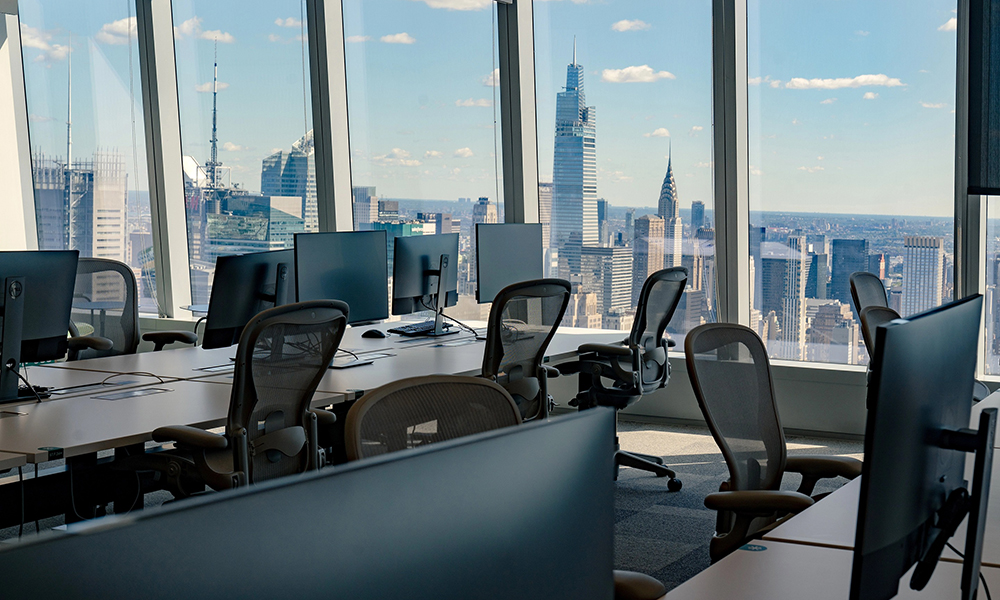美国商业地产崩盘还是软着陆?高盛指出三大风险

今年第一季度,旧金山和曼哈顿的办公楼空置率创新高,分别达到29.4%和16%。高盛(Goldman Sachs)预测,情况可能会越来越糟糕。
周一,高盛分析师发布了一份报告称,商业地产经过两年快速升值和对其优势的大肆宣传,该市场“逐渐转向更加负面的叙事”。分析师提到了因租金增速下降和空置率升高(在个别情况下)所导致的净营业收入下行压力,这些趋势加剧了商业地产行业的脆弱性,使商业地产借款人偿债能力受到冲击的风险升高。
但正如Cohen&Steers的里奇·希尔之前对《财富》杂志所说,将商业地产作为一类单独资产并不公平;相反,商业地产囊括了多个子行业。高盛分析师也认同这种观点。他们表示“对商业地产采取一刀切式的策略,忽视了不同地产类型之间重要的根本性的细微差别。”高盛分析师表示,实话实说,由于上班族反对朝九晚五的传统办公模式,而是更愿意远程办公,导致商业地产空置率升高并持续贬值,这应该引起所有人的关注。
分析师写道:“最近几个月,办公楼一直备受投资者关注,我们认为这种重视很有道理。商业地产存在的许多根本性问题,早在去年政策利率上浮之前就已经存在。与此同时,他们认为,多户住宅和工业地产普遍依旧相对有弹性。
但房地产市场未来依旧面临困境,高盛分析师特别提到了三个近在眼前的风险。以下是他们提到的三种风险。
1. 商业地产借款人要承受更高利率
高盛分析师认为随着商业房地产市场进入融资成本更高的环境,有三个驱动因素将带来挑战。第一个因素是商业地产借款人承担浮动利率负债的风险升高。
分析师写道:“虽然贷款人通常要求浮动利率贷款同时设定利率上限,但借款人依旧面临利率升高突破上限的风险。”他们表示,即便如此,利率上限的持续时间通常比抵押贷款利率的期限更短,这意味着对冲交易的成本可能会更高。
2. 以更高利率进行再融资,冲击商业地产
除了借款人对浮动利率负债的敏感性提高外,分析师表示,商业地产在近期内进行再融资的需求升高。他们估计,到2024年年底之前,将有1.07万亿美元的抵押贷款到期。而摩根士丹利(Morgan Stanley)估计,在超过2.9万亿美元的商业抵押贷款中,超过50%需要在未来24个月重新谈判。分析师表示,尽管如此,“许多借款人可能不得不将其固定利率贷款按更高利率进行再融资。”但对于办公楼和零售等陷入困境的房地产,借款人再融资或延长贷款期限的能力与意愿都将受到限制。
3. 银行倒闭导致贷款标准更严格
高盛分析师认为,未来融资条件可能会进一步收紧。分析师没有将未来更严格的贷款条件,明确归咎于上个月的银行倒闭,而是强调了银行在促进商业地产交易方面所扮演的角色。但正如《财富》杂志之前的报道所说,随着美联储开始加息,贷款标准已经变得更严格,银行倒闭可能导致情况进一步恶化。但高盛分析师表示,到去年年底,美国未偿商业贷款规模为5.6万亿美元,“小银行所占的份额远高于大银行。”(有专家对这种观点提出质疑。他们对《财富》杂志表示,小银行的商业地产债务低于大银行,但可能存在更大风险。)
高盛分析师写道:“小银行对商业地产尤其重要:美国前25大银行(按资产规模)以外的机构,发放了70%的银行商业抵押贷款。)小银行信贷可用性下降,极有可能对美国商业地产行业造成破坏,更糟糕的是,办公楼和零售等最依赖银行融资的部门,同样面临最高的功能性报废风险。”
这对于商业地产或者更准确地说,对于该资产类别中的办公楼等子行业而言,到底意味着什么?总而言之,这类资产的净营业收入将面临更大压力,空置率升高,而且拖欠债务的情况将会增多。
高盛分析师表示:“这种恶性循环持续的时间越长,借款人就越不愿意延长和修改现有贷款,反而更愿意策略性违约,并对其资产进行清算。”(财富中文网)
翻译:刘进龙
审校:汪皓
今年第一季度,旧金山和曼哈顿的办公楼空置率创新高,分别达到29.4%和16%。高盛(Goldman Sachs)预测,情况可能会越来越糟糕。
周一,高盛分析师发布了一份报告称,商业地产经过两年快速升值和对其优势的大肆宣传,该市场“逐渐转向更加负面的叙事”。分析师提到了因租金增速下降和空置率升高(在个别情况下)所导致的净营业收入下行压力,这些趋势加剧了商业地产行业的脆弱性,使商业地产借款人偿债能力受到冲击的风险升高。
但正如Cohen&Steers的里奇·希尔之前对《财富》杂志所说,将商业地产作为一类单独资产并不公平;相反,商业地产囊括了多个子行业。高盛分析师也认同这种观点。他们表示“对商业地产采取一刀切式的策略,忽视了不同地产类型之间重要的根本性的细微差别。”高盛分析师表示,实话实说,由于上班族反对朝九晚五的传统办公模式,而是更愿意远程办公,导致商业地产空置率升高并持续贬值,这应该引起所有人的关注。
分析师写道:“最近几个月,办公楼一直备受投资者关注,我们认为这种重视很有道理。商业地产存在的许多根本性问题,早在去年政策利率上浮之前就已经存在。与此同时,他们认为,多户住宅和工业地产普遍依旧相对有弹性。
但房地产市场未来依旧面临困境,高盛分析师特别提到了三个近在眼前的风险。以下是他们提到的三种风险。
1. 商业地产借款人要承受更高利率
高盛分析师认为随着商业房地产市场进入融资成本更高的环境,有三个驱动因素将带来挑战。第一个因素是商业地产借款人承担浮动利率负债的风险升高。
分析师写道:“虽然贷款人通常要求浮动利率贷款同时设定利率上限,但借款人依旧面临利率升高突破上限的风险。”他们表示,即便如此,利率上限的持续时间通常比抵押贷款利率的期限更短,这意味着对冲交易的成本可能会更高。
2. 以更高利率进行再融资,冲击商业地产
除了借款人对浮动利率负债的敏感性提高外,分析师表示,商业地产在近期内进行再融资的需求升高。他们估计,到2024年年底之前,将有1.07万亿美元的抵押贷款到期。而摩根士丹利(Morgan Stanley)估计,在超过2.9万亿美元的商业抵押贷款中,超过50%需要在未来24个月重新谈判。分析师表示,尽管如此,“许多借款人可能不得不将其固定利率贷款按更高利率进行再融资。”但对于办公楼和零售等陷入困境的房地产,借款人再融资或延长贷款期限的能力与意愿都将受到限制。
3. 银行倒闭导致贷款标准更严格
高盛分析师认为,未来融资条件可能会进一步收紧。分析师没有将未来更严格的贷款条件,明确归咎于上个月的银行倒闭,而是强调了银行在促进商业地产交易方面所扮演的角色。但正如《财富》杂志之前的报道所说,随着美联储开始加息,贷款标准已经变得更严格,银行倒闭可能导致情况进一步恶化。但高盛分析师表示,到去年年底,美国未偿商业贷款规模为5.6万亿美元,“小银行所占的份额远高于大银行。”(有专家对这种观点提出质疑。他们对《财富》杂志表示,小银行的商业地产债务低于大银行,但可能存在更大风险。)
高盛分析师写道:“小银行对商业地产尤其重要:美国前25大银行(按资产规模)以外的机构,发放了70%的银行商业抵押贷款。)小银行信贷可用性下降,极有可能对美国商业地产行业造成破坏,更糟糕的是,办公楼和零售等最依赖银行融资的部门,同样面临最高的功能性报废风险。”
这对于商业地产或者更准确地说,对于该资产类别中的办公楼等子行业而言,到底意味着什么?总而言之,这类资产的净营业收入将面临更大压力,空置率升高,而且拖欠债务的情况将会增多。
高盛分析师表示:“这种恶性循环持续的时间越长,借款人就越不愿意延长和修改现有贷款,反而更愿意策略性违约,并对其资产进行清算。”(财富中文网)
翻译:刘进龙
审校:汪皓
Office vacancy rates in San Francisco and Manhattan have hit new highs, climbing up to 29.4% and 16%, respectively, in the first quarter of this year. And according to Goldman Sachs, it could get worse from here.
On Monday, analysts at Goldman Sachs published a note arguing that after two years of rapidly increasing valuations and praises of its strength, “the narrative has turned much more negative” for the commercial real estate market. Analysts cited downward pressure on net operating income due to declining rent growth and rising vacancy rates (in some cases), all of which has exacerbated the sector’s vulnerability, putting commercial real estate borrowers at a higher risk of payment shock on their liabilities.
But as Cohen & Steers’ Rich Hill previously told Fortune, looking at commercial real estate as one singular asset class does not do it justice; rather, it’s several subsectors under one umbrella. Goldman Sachs analysts suggested the same, that a “one-size-fits-all approach to the CRE market loses sight of important fundamental nuances between the various property types.” Truth be told, Goldman Sachs analysts say all eyes should be on office properties, which have struggled with rising vacancy rates and falling valuations as workers push back against the traditional nine-to-five and instead lean into remote work.
“Office has been the subject of high investor focus in recent months, and rightly so, in our view,” analysts wrote. “Many of this segment’s fundamental headwinds preceded last year’s back-up in policy rates.” Meanwhile, they argue that multifamily and industrial properties generally remain relatively resilient.
Still, there’s trouble ahead for the sector, particularly due to three looming risks that Goldman Sachs’ analysts pointed to. Let’s take a look.
1. Commercial real estate borrowers are exposed to higher rates
The first of three drivers that Goldman Sachs analysts argue will pose a challenge as the commercial real estate market transitions to a higher funding cost environment is CRE borrowers’ increased exposure to floating rate liabilities.
“While lenders often require floating rate loans to be paired with interest rate caps…borrowers are still exposed to higher rates up to the cap’s strike,” wrote analysts. Even so, they said, the duration of the cap is typically shorter than the mortgage, which means that hedges may need to be reset at a higher cost.
2. Refinancing at higher rates will be painful for CRE
Along with borrowers’ increased sensitivity to floating rate liabilities, analysts say, the need to refinance in the near term is elevated. Their estimate is that $1.07 trillion worth of mortgage loans will mature before year-end 2024. Morgan Stanley, on the other hand, estimated that more than 50% of $2.9 trillion in commercial mortgages will need to be renegotiated in the next 24 months. That being said, “many borrowers will likely have to refinance their fixed rate loans at higher rates,” analysts wrote. But for beleaguered property types, like office and retail, the ability and willingness of borrowers to refinance or extend loans will be limited.
3. Bank failures spell tighter lending standards
Goldman Sachs analysts suggested that financing conditions are likely to further tighten as we move forward. Analysts don’t explicitly blame last month’s bank failures for the stricter lending conditions ahead, but rather emphasize the role banks play in facilitating commercial real estate transactions. But as Fortune has previously reported, the bank failures are likely to exacerbate the already tighter lending standards that have been in play since the Fed began with its rate hikes. Nonetheless, according to Goldman Sachs analysts, by the end of last year, there was $5.6 trillion in outstanding commercial loans in the U.S., “with small banks capturing a much larger share than large banks.” (Some experts dispute this claim, telling Fortune that smaller banks hold less commercial real estate debt than larger banks but can have greater exposure.)
“Small banks are particularly important to the CRE market: 70% of bank commercial mortgage holdings sit outside the top 25 largest banks (by assets),” wrote Goldman Sachs analysts. “The potential for disruptions to U.S. commercial real estate activity from a pullback in small bank credit availability is substantial, unaided by the fact that the segments most dependent on bank financing—offices and retail properties—are also facing the strongest risk of functional obsolescence.”
So what does this all mean for commercial real estate, or better said, particular subsectors within the asset class, like office properties? Simply put, further pressure on net operating income and increasing vacancy, along with an increase in delinquencies.
Goldman Sachs analysts said: “The more this negative loop persists, the less incentivized borrowers are to extend and modify existing loans and the more incentivized they are to strategically default and look to liquidate their properties.”













